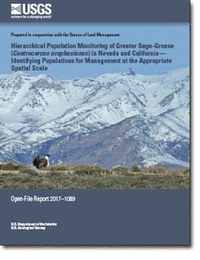Hierarchical population monitoring of greater sage-grouse (Centrocercus urophasianus) in Nevada and California—Identifying populations for management at the appropriate spatial scale
Links
- Document: Report (15.9 MB pdf)
- Download citation as: RIS | Dublin Core
Abstract
Population ecologists have long recognized the importance of ecological scale in understanding processes that guide observed demographic patterns for wildlife species. However, directly incorporating spatial and temporal scale into monitoring strategies that detect whether trajectories are driven by local or regional factors is challenging and rarely implemented. Identifying the appropriate scale is critical to the development of management actions that can attenuate or reverse population declines. We describe a novel example of a monitoring framework for estimating annual rates of population change for greater sage-grouse (Centrocercus urophasianus) within a hierarchical and spatially nested structure. Specifically, we conducted Bayesian analyses on a 17-year dataset (2000–2016) of lek counts in Nevada and northeastern California to estimate annual rates of population change, and compared trends across nested spatial scales. We identified leks and larger scale populations in immediate need of management, based on the occurrence of two criteria: (1) crossing of a destabilizing threshold designed to identify significant rates of population decline at a particular nested scale; and (2) crossing of decoupling thresholds designed to identify rates of population decline at smaller scales that decouple from rates of population change at a larger spatial scale. This approach establishes how declines affected by local disturbances can be separated from those operating at larger scales (for example, broad-scale wildfire and region-wide drought). Given the threshold output from our analysis, this adaptive management framework can be implemented readily and annually to facilitate responsive and effective actions for sage-grouse populations in the Great Basin. The rules of the framework can also be modified to identify populations responding positively to management action or demonstrating strong resilience to disturbance. Similar hierarchical approaches might be beneficial for other species occupying landscapes with heterogeneous disturbance and climatic regimes.
Suggested Citation
Coates, P.S., Prochazka, B.G., Ricca, M.A., Wann, G.T., Aldridge, C.L., Hanser, S.E., Doherty, K.E., O’Donnell, M.S., Edmunds, D.R., and, Espinosa, S.P., 2017, Hierarchical population monitoring of greater sage-grouse (Centrocercus urophasianus) in Nevada and California—Identifying populations for management at the appropriate spatial scale: U.S. Geological Survey Open-File Report 2017-1089, 49 p., https://doi.org/10.3133/ofr20171089.
ISSN: 2331-1258 (online)
Study Area
Table of Contents
- Preface
- Acknowledgments
- Abstract
- Synopsis
- Introduction
- Study Objectives
- Methods
- Results
- Discussion
- Conclusion
- References Cited
| Publication type | Report |
|---|---|
| Publication Subtype | USGS Numbered Series |
| Title | Hierarchical population monitoring of greater sage-grouse (Centrocercus urophasianus) in Nevada and California—Identifying populations for management at the appropriate spatial scale |
| Series title | Open-File Report |
| Series number | 2017-1089 |
| DOI | 10.3133/ofr20171089 |
| Publication Date | August 10, 2017 |
| Year Published | 2017 |
| Language | English |
| Publisher | U.S. Geological Survey |
| Publisher location | Reston, VA |
| Contributing office(s) | Western Ecological Research Center |
| Description | viii, 49 p. |
| Country | United States |
| State | California, Nevada |
| Online Only (Y/N) | Y |


